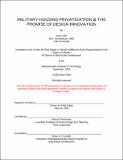| dc.contributor.advisor | Dennis Frenchman. | en_US |
| dc.contributor.author | Ellis, Jason (Jason Robert) | en_US |
| dc.contributor.other | Massachusetts Institute of Technology. Center for Real Estate. Program in Real Estate Development. | en_US |
| dc.date.accessioned | 2010-05-25T19:20:03Z | |
| dc.date.available | 2010-05-25T19:20:03Z | |
| dc.date.copyright | 2009 | en_US |
| dc.date.issued | 2009 | en_US |
| dc.identifier.uri | http://hdl.handle.net/1721.1/54848 | |
| dc.description | Thesis (S.M.)--Massachusetts Institute of Technology, Program in Real Estate Development in Conjunction with the Center for Real Estate , 2009. | en_US |
| dc.description | This electronic version was submitted by the student author. The certified thesis is available in the Institute Archives and Special Collections. | en_US |
| dc.description | Cataloged from student submitted PDF version of thesis. | en_US |
| dc.description | Includes bibliographical references (p. 66-68). | en_US |
| dc.description.abstract | The objective of this paper is to answer the question, "Has the military housing privatization process produced design innovation?" Secondary questions are, "What specific role has the Army's Residential Communities Initiative played in fostering innovation? What are the key process drivers? What (if any) specific building product innovations have arisen from an architectural, sustainability, construction technology and community planning perspective over the last 10-15 years?" Particular emphasis is paid to design measures employed by the development partners to ensure client satisfaction, maintain the competitiveness of their product on the open market and preserve long term partnerships with the U.S. Government. Consideration is given to the ways in which the Army has streamlined the privatization solicitation process to foster private sector innovation and what impacts these efforts have had on both design drivers and customer satisfaction levels. Specific examples of planning, design and construction innovation are explored through case studies. The author concludes that privatization has produced significant innovation and high customer satisfaction in the military housing market. However, there is still room for further program innovation in light of parallel trends in university student housing privatization, public housing privatization and the private market. Research methodology included relevant literature review and direct, focused interviews with key industry players from the U.S. Government, design and development arenas. These approaches were augmented with select, relevant case study analyses and supporting site visits.. | en_US |
| dc.description.statementofresponsibility | by Jason Ellis. | en_US |
| dc.format.extent | 121 p. | en_US |
| dc.language.iso | eng | en_US |
| dc.publisher | Massachusetts Institute of Technology | en_US |
| dc.rights | M.I.T. theses are protected by
copyright. They may be viewed from this source for any purpose, but
reproduction or distribution in any format is prohibited without written
permission. See provided URL for inquiries about permission. | en_US |
| dc.rights.uri | http://dspace.mit.edu/handle/1721.1/7582 | en_US |
| dc.subject | Center for Real Estate. Program in Real Estate Development. | en_US |
| dc.title | Military housing privatization & the promise of design innovation | en_US |
| dc.title.alternative | Military housing privatization and the promise of design innovation | en_US |
| dc.type | Thesis | en_US |
| dc.description.degree | S.M. | en_US |
| dc.contributor.department | Massachusetts Institute of Technology. Center for Real Estate. Program in Real Estate Development. | en_US |
| dc.contributor.department | Massachusetts Institute of Technology. Center for Real Estate | |
| dc.identifier.oclc | 608096099 | en_US |
